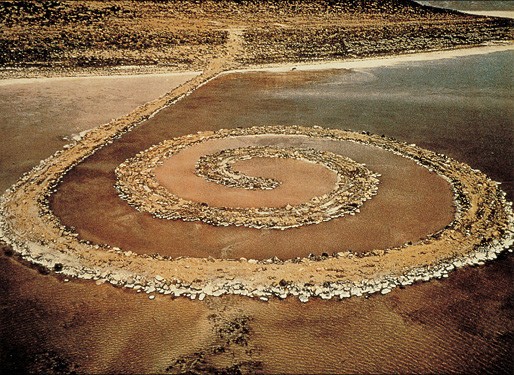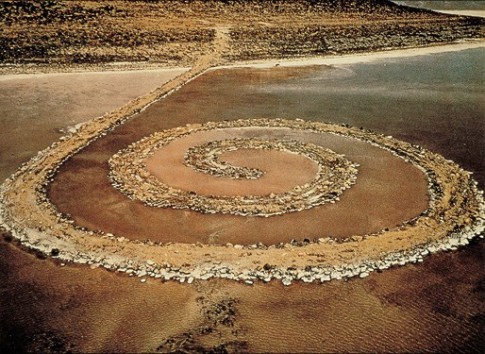
Robert Smithson, Spiral Jetty, 1970 © Robert Smithson/BUS 2012
About Robert Smithson
A FREE-THINKING ARTIST
He mistrusted objectivity and rationality, the view of man as the centre of the universe; he also questioned modernism’s exaggerated faith in control as well as the cult of harmony and purity. In a surprising and direct way Smithson challenged the ways in which we perceive the world. His work confronts us with questions which are timely and relevant even today: What constitutes a work of art? What is the relationship between art and reality? Where does art belong?
In many ways Smithson anticipated attitudes and subjects that occupy young artists today. For him the artist was a many-faceted, “jack of all trades”, who could ponder equally the relationship between the centre and the periphery, between science and science fiction, the role of process, the magic of film, the existential character of myth, and the question of how one area of thought, knowledge and experience could be echoed symbolically or actually in another. Both the natural sciences and popular culture were important sources of inspiration and he was as fascinated by American suburbia as he was by sublime landscape. These subjects appear in his writings: in 1968 he wrote that “there is nothing ‘natural’ about a Museum of Natural History. ‘Nature’ is simply another 18th and 19th century fiction.”
The present retrospective exhibition is the second to show his work in all its breadth: everything from the early, and to up to now wholly unknown, painting influenced by Beat Culture, his minimal related objects, sites or non-sites, audio-visual “lectures” to the spectacular outdoor work like “Glue Pour” and the construction film, “Spiral Jetty”.
MYTHICAL WORLDS AND BROKEN LOGIC
Robert Smithson described his “Woodcuts” as the work that took him from the New Jersey suburbs, where he grew up, to big city Manhattan. Influenced by Abstract Expressionism and its emotional intensity, his work in 1955-1961 centred around existential experiences of suffering combined with a keen sense of paradox. Later the plain narrative was replaced by parallel events. Whether working with painting, graphics or collage, Smithson depicts, ornamentally and rhythmically, various kinds of mythical worlds which run from Catholic and Orthodox religion to natural science and science fiction.
Like his contemporaries, the neo-dadaists and Fluxus artists, he borrows from the world of the mass-media, not least from films, which now began to be important for him. Christ and mermaids, dinosaurs and King Kong, pin-ups and homo-erotic scenes – all find a place in his work. He combines the high with the low, the heavenly with the demonic, the lyrical with the brutal, the past with the future. His work is often made in series, for instance, the series of drawings, “Hitler’s opera”, where Hitler is depicted as a macabre death-machine, from birth to death. Drawing was a tool Smithson used throughout his career – for notes, sketches and presentations, but first and foremost, drawing was the medium in which his ideas took shape, were revised and developed.
Robert Smithsons early sculptures were made from what were at the time relatively new industrial materials like plastic and phosphorescent colour, but he also used more traditional materials like steel and plate glass. Several of his sculptures are figurative, as for example “Honeymoon Machine”, and show that the natural forces he was interested in also include sexuality. “Mirror Vortex” is part of a group of works in which the viewer looks into the sculpture rather than at its outside. When one leans over and looks into it one sees a broken field of vision where ones own mirror image is fragmented and multiplied. “Pointless Vanishing Point” is an example of how instead of treating vanishing point perspective as a natural instrument of seeing, Smithson makes it into a thing, an abstract entity, which is examined and questioned. An established system analysed before it is broken and logic becomes illogical. These pseudo-minimalist sculptures are often based on geological comparisons; Smithson thought of the crystal not only as form but also as development principle that could be used as a reference for all existence. In this way, he was able to borrow a metaphor from nature without having to be biological. “Gyrostasis” is a result of the crystal form principle: the title comes from that part of physics that deals with rotating bodies and their tendency to maintain balance.
Whereas existential life conditions were a central theme in Smithsons early works, from the mid-1960s, he focused more on human context. From having previously often depicted people in pictures, he began to make the viewer, the main character in his work. During the second half of the ’60s, he participated together with artists like Donald Judd, Sol LeWitt, Carl Andre and Eva Hesse, in several legendary exhibitions of minimal art such as “Primary Structures” at the Jewish Museum in New York in 1966.
CULTURE, LANDSCAPE AND ENTROPY*
A significant part of Robert Smithson’s work is his writing. This began with the poetry he wrote in his youth; from 1965 he published, in art and culture journals as Artforum and Aspen, texts that covered such topics as contemporary art, his own work, history writing, and the making of Central Park. He often designed the graphics for these articles and criticised all frozen or deadlocked views of art and conveyed a personal way of relating to the world in all its varied expressions. In “Entropy and the New Monuments”, for example, he writes about how the new type of monumental work that he and his contemporaries were creating evokes an Ice Age rather than a Golden Age. Instead of awakening memories of the past, they make the viewer forget the future. He also developed his critique of the institutions of art: arguing, for instance, that museums destroy our sensibilities by their unfortunate division of art into categories such as painting, sculpture, and architecture. He did not reject art institutions – where he continued to exhibit throughout his life – but he urged greater consciousness of the context the artist was working in.
His projects outside museums and galleries began in earnest in 1969 when he made “Asphalt Rundown” and “Glue Pour”, where large amounts of asphalt and glue were poured out in certain places in the landscape. These happenings “painted” the landscape in a way reminiscent of action painting, but also of volcanic eruptions and natural disasters. A number of other works consisted of transferring mirrors into nature, for example, “Ithaca Mirror Trail” and “Yucatan Mirror Displacement”. In these temporary landmarks the mirrors created illusions which fragmented and distorted the world around them – they have been called “rectangles of indetermination” – and in this way they indicated the difficulty, if not impossibility, of “pure” vision.
Many of these short-lived interventions in nature are documented, in series of two to over thirty slides. The most well known of these is “Hotel Palenque”, where the artist himself delivers a lecture to his own photographs of a Mexican hotel which is being built and torn down on the same occasion.
* The concept of entropy (from the Greek meaning transformation) can be seen as a sensory image for those works. Entropy, generally, is a measure of disorder in situations where different ingredients are mixed together. In a figurative sense, entropy is about how nature recovers what people have taken or tampered with.
MAPS, NONSITES AND SUBURBS
The work that Robert Smithson started making in 1968 as nonsites was constructed around natural materials like stone or gravel, containers for these materials, and included maps, photographs or texts referring to the places from where the natural materials were taken. The stones are placed in foreshortened wooden boxes in “A Nonsite (Franklin, New Jersey)”, the gravel in “Grave Mirrors with Cracks and Dust” is laid directly on a mirror, without a container. The 15 ton “Mirrors with Shelly Sand” is Smithsons only instruction piece, and has not been shown since it was first presented in Chicago in 1970.
These works provoke questions about the relation between centre and periphery, edge and surface, interior and exterior, nature and culture. The literal and immediate exists side by side, and the constructed exhibition space interpenetrates with the outside world. They also investigate artistic references and Smithson emphasised that they related to something other than themselves which exists outside the museum’s walls. Instead of placing a sculpture in a landscape, he literally takes the landscape into the museum. These works appeared at the same time as a parallel development in literature and film: both Alain Robbe-Grillet and Michelangelo Antonioni, for example, were experimenting with real time. Maps often crop up in Smithsons work. Not only are they an important aid to orienting oneself in the environment, they also illuminate problems of representation as they are both image and literature, both analogues as well as digital sign systems. For Smithson, all places were interesting, regardless of whether they were remote wilderness or derelict suburban industrial landscapes. The travel essay, “A Tour of the Monuments of Passaic”, records a bus trip from Manhattan to the small town of Passaic in New Jersey where Smithson grew up. With insight and humour he depicts Passaics buildings and ruins – a sandbox and a broken sewage pipe for example – as if they were monuments in Rome.
UNDERMINING STABILITY
In 1970-71 Smithson made three large earthworks, where he underlined the process of their making and let the works be exposed to destructive forces. This was one literal way of undermining their stability. “Partially Buried Woodshed” is usually considered his most entropic work: an abandoned shed was buried in earth at Kent State University in Ohio. The work was finished when the beams cracked, i.e.. when the decay became visible. “Broken Circle/Spiral Hill”, an abandoned sandpit in Emmen, Holland, was his first land reclamation project, where in the name of art and through simple changes and more or less violent interventions in the landscape, he reclaims an area of nature.
Several of Smithsons last works involved land reclamation projects that were never carried out, like Bingham Copper Mining Pit, Utah, which encompassed an already existing 1000 meter deep, terraced open pit mine, where he wanted to make a circular lake with jetties on its bottom. The monumental “Spiral Jetty” has become an icon, not only of Robert Smithsons art, but also of a period when the boundaries of art were challenged and stretched. The “Spiral Jetty” is a 480 meter long and 4.80 meter wide spiral-shaped jetty of sand and stone in the Great Salt Lake in Utah. Simple in form and made from material from the site, it is a typical earth-work construction of that time. The choice of site was determined by the salt lakes reddish water.
In 1972 Smithson wrote an essay called Spiral Jetty and then made a 35 minute-long 16mm film. The film is a mixture of a documentary taken during the making of the jetty, a science fiction film and thriller. The scene where the artist is filmed from a helicopter running on the jetty conjures up Alfred Hitchcock’s film “North by Northwest”. Many have pointed out that it is difficult to separate the earth-work, the text and the film. Against this background, “Spiral Jetty” seems to be a hybrid of many different forms, becoming perhaps a special aesthetic category of its own.

